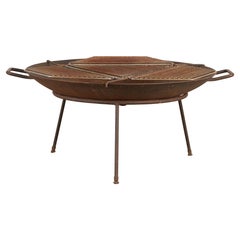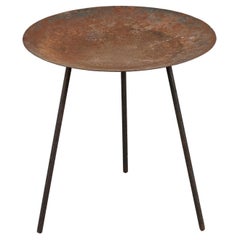Three Legged Fire Pit
Mid-20th Century American Mid-Century Modern Fireplaces and Mantels
Metal, Iron
Recent Sales
Vintage 1950s American Mid-Century Modern Fireplaces and Mantels
Iron
Mid-20th Century American Mid-Century Modern Fireplaces and Mantels
Iron
Mid-20th Century North American Mid-Century Modern Fireplaces and Mantels
Metal, Iron
People Also Browsed
Vintage 1950s American Mid-Century Modern Fireplaces and Mantels
Metal, Iron
A Close Look at Mid-century-modern Furniture
Organically shaped, clean-lined and elegantly simple are three terms that well describe vintage mid-century modern furniture. The style, which emerged primarily in the years following World War II, is characterized by pieces that were conceived and made in an energetic, optimistic spirit by creators who believed that good design was an essential part of good living.
ORIGINS OF MID-CENTURY MODERN FURNITURE DESIGN
- Emerged during the mid-20th century
- Informed by European modernism, Bauhaus, International style, Scandinavian modernism and Frank Lloyd Wright’s architecture
- A heyday of innovation in postwar America
- Experimentation with new ideas, new materials and new forms flourished in Scandinavia, Italy, the former Czechoslovakia and elsewhere in Europe
CHARACTERISTICS OF MID-CENTURY MODERN FURNITURE DESIGN
- Simplicity, organic forms, clean lines
- A blend of neutral and bold Pop art colors
- Use of natural and man-made materials — alluring woods such as teak, rosewood and oak; steel, fiberglass and molded plywood
- Light-filled spaces with colorful upholstery
- Glass walls and an emphasis on the outdoors
- Promotion of functionality
MID-CENTURY MODERN FURNITURE DESIGNERS TO KNOW
- Charles and Ray Eames
- Eero Saarinen
- Milo Baughman
- Florence Knoll
- Harry Bertoia
- Isamu Noguchi
- George Nelson
- Danish modernists Hans Wegner and Arne Jacobsen, whose emphasis on natural materials and craftsmanship influenced American designers and vice versa
ICONIC MID-CENTURY MODERN FURNITURE DESIGNS
- Eames lounge chair
- Nelson daybed
- Florence Knoll sofa
- Egg chair
- Womb chair
- Noguchi coffee table
- Barcelona chair
VINTAGE MID-CENTURY MODERN FURNITURE ON 1STDIBS
The mid-century modern era saw leagues of postwar American architects and designers animated by new ideas and new technology. The lean, functionalist International-style architecture of Le Corbusier and Bauhaus eminences Ludwig Mies van der Rohe and Walter Gropius had been promoted in the United States during the 1930s by Philip Johnson and others. New building techniques, such as “post-and-beam” construction, allowed the International-style schemes to be realized on a small scale in open-plan houses with long walls of glass.
Materials developed for wartime use became available for domestic goods and were incorporated into mid-century modern furniture designs. Charles and Ray Eames and Eero Saarinen, who had experimented extensively with molded plywood, eagerly embraced fiberglass for pieces such as the La Chaise and the Womb chair, respectively.
Architect, writer and designer George Nelson created with his team shades for the Bubble lamp using a new translucent polymer skin and, as design director at Herman Miller, recruited the Eameses, Alexander Girard and others for projects at the legendary Michigan furniture manufacturer.
Harry Bertoia and Isamu Noguchi devised chairs and tables built of wire mesh and wire struts. Materials were repurposed too: The Danish-born designer Jens Risom created a line of chairs using surplus parachute straps for webbed seats and backrests.
The Risom lounge chair was among the first pieces of furniture commissioned and produced by celebrated manufacturer Knoll, a chief influencer in the rise of modern design in the United States, thanks to the work of Florence Knoll, the pioneering architect and designer who made the firm a leader in its field. The seating that Knoll created for office spaces — as well as pieces designed by Florence initially for commercial clients — soon became desirable for the home.
As the demand for casual, uncluttered furnishings grew, more mid-century furniture designers caught the spirit.
Classically oriented creators such as Edward Wormley, house designer for Dunbar Inc., offered such pieces as the sinuous Listen to Me chaise; the British expatriate T.H. Robsjohn-Gibbings switched gears, creating items such as the tiered, biomorphic Mesa table. There were Young Turks such as Paul McCobb, who designed holistic groups of sleek, blond wood furniture, and Milo Baughman, who espoused a West Coast aesthetic in minimalist teak dining tables and lushly upholstered chairs and sofas with angular steel frames.
Generations turn over, and mid-century modern remains arguably the most popular style going. As the collection of vintage mid-century modern chairs, dressers, coffee tables and other furniture for the living room, dining room, bedroom and elsewhere on 1stDibs demonstrates, this period saw one of the most delightful and dramatic flowerings of creativity in design history.
Finding the Right Fireplaces-mantels for You
While we likely wouldn’t mourn the invention of home heating and air-conditioning, these innovations did tragically reduce the widespread need for fireplaces and mantels in our living rooms.
Once an essential fixture in all homes, the fireplace, which, along with the chimney, is as old as the Middle Ages, was actually rendered redundant with the advent of the cast-iron heating stove during the 18th century. Victorian-era heating stoves were popular in the common areas of a living space for their capacity to heat as well as for their lack of smoke compared to fireplaces. However, improvements in craftsmanship as well as the Industrial Revolution meant that fireplaces were evolving in form and functionality.
Even as HVAC systems would eventually see to it that fireplaces weren’t a necessity, no mechanically engineered thermal heating and ventilation technology can replicate the feeling of warmth and camaraderie that a flickering fire guarantees. We just love a good fireplace.
“With antique fireplaces, you get heart, soul, character and architecture,” says Tony Ingrao, a Manhattan-based interior designer who purchased an important 16th-century French limestone fireplace for a client’s Greenwich Village townhouse.
Vintage fireplaces and mantels have earned their coveted position as desirable focal points in any room over the course of a staggering evolution in design that has yielded everything from intricately carved works of limestone to sleek works of wood paneling and rolled steel.
As log after log turns into ash, these iconic designs prove their timelessness and value, monetarily and as prized decorative monuments. Whether you seek to simply warm a space or completely transform it, an eye-catching new mantel for your blazing hearth — be it an elegant neoclassical design, a marvelous work of marble in the Louis XV style or an unconventional contemporary variation — is the perfect solution.
Find a collection of antique and vintage fireplaces and mantels on 1stDibs today.
Read More
39 Incredible Swimming Pools
It's hard to resist the allure of a beautiful pool. So, go ahead and daydream about whiling away your summer in paradise.
May’s Most Popular Interiors on Instagram
Our feed is filled with the world's most beautiful spaces. See the rooms our followers have deemed the best of the best this month.
April’s Most-Liked Interiors on Instagram
Our feed is filled with the world's most beautiful spaces. See the 10 our followers have deemed the best of the best this month.


